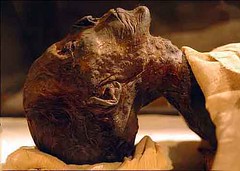Hatshepsut, meaning Foremost of Noble Ladies,[4] (1508 BC - 1458 BC), is generally regarded by Egyptologists as one of the most successful pharaohs, reigning longer than any other woman of an indigenous Egyptian dynasty, says Wikipedia.
Although it was uncommon for Egypt to be ruled by a woman, the situation was not unprecedented.
In comparison with other female pharaohs, Hatshepsut's reign was long and prosperous. She was successful in warfare early in her reign, but generally is considered to be a pharaoh who inaugurated a long peaceful era.
She re-established trading relationships lost during a foreign occupation and brought great wealth to Egypt. That wealth enabled Hatshepsut to initiate building projects that raised the calibre of Ancient Egyptian architecture to a standard, comparable to classical architecture, that would not be rivaled by any other culture for a thousand years.
She oversaw the preparations and funding for a mission to the Land of Punt. Most notably the Egyptians returned from the voyage bearing live frankincense trees, the roots of which were carefully kept in baskets for the duration of the voyage. This was the first recorded attempt to transplant foreign trees.
Hatshepsut was one of the most prolific builders in ancient Egypt, commissioning hundreds of construction projects throughout both Upper Egypt and Lower Egypt, that were grander and more numerous than those of any of her Middle Kingdom predecessors. Later pharaohs attempted to claim some of her projects as theirs.
She had twin obelisks, at the time the tallest in the world, erected at the entrance to the temple at Karnak.
Following the tradition of many pharaohs, the masterpiece of Hatshepsut's building projects was her mortuary temple. She built hers in a complex at Deir el-Bahri.
Women had a high status in ancient Egypt and enjoyed the legal right to own, inherit, or will property. A woman becoming pharaoh was rare, however.
Hatshepsut assumed all of the regalia and symbols of the pharaonic office in official representations: the Khat head cloth, topped with the uraeus, the traditional false beard, and shendyt kilt.[17] Many existing statues alternatively show her in typically feminine attire as well as those that depict her in the royal ceremonial attire.
If the recent identification of her mummy is correct, computed tomography would indicate that she died of blood infection while she was in her fifties.[2][28] It also would suggest that she had arthritis, bad teeth, and probably had diabetes.[2]
Toward the end of the reign of Thutmose III and into the reign of his son, an attempt was made to remove Hatshepsut from certain historical and pharaonic records. This elimination was carried out in the most literal way possible. Her cartouches and images were chiselled off some stone walls, leaving very obvious Hatshepsut-shaped gaps in the artwork.
skip to main |
skip to sidebar
For students and parents who love education and exploration of the social sciences . . .
Search This Blog
Followers
Blog Archive
-
▼
2010
(346)
-
▼
March
(51)
- What's surprising and significant in the compariso...
- Thurs, Ap 1: Vietnam plus Korea map quiz as well a...
- Korea: another nation divided between communist an...
- Orienting ourselves to the Pacific rim nations
- Review of Presidents in Vietnam project
- Thanks for supporting the Class of 2013 Magnet Tal...
- Informal presidential review . . .
- Vietnam: 58,000 US dead, some 4 million Vietnamese...
- 1972, South Vietnam: the Victims Of War
- Shot Heard Around The World: Execution of a Viet C...
- Due Thurs: Colorful map of Vietnam
- Vietnam and the Chinese, French and the US: a hist...
- In-class project: Four presidents and US involveme...
- The largest and most technologically advanced ship...
- Indie work: briefly compare the war in Iraq and Vi...
- Vietnam veteran interview due Mon, Ap 5; 15 pts
- Washington to Hanoi: Vietnam review
- Sitar & Tabla: the unusual musical instruments of ...
- Indie work deadline Sun, Mar 14, noon, for this 9 ...
- Eric Johnson's Gandhi project: effective digital d...
- Freshman Talent Show: Wed, Mar 24, 6:30 pm, PAC; i...
- Shreveport's Hindu Cultural Center since 2006
- Western world stress relief: Hatha Yoga from India
- Gandhi's tactics: use media, the law, Christianity...
- Watching the movie Gandhi for useful quotes . . .
- India: land of many cuisines
- Gandhi map project due Thurs; 15 pts
- Sari vs kimono and other indie comparison topics
- The 78-year journey of Mohandas Karamchand Gandhi
- Mumbai / Bombay: one of the world's most populous ...
- Slumdog Millionaire and other recommended movies o...
- India: Land of Curry, land of Hinduism
- Indie work: comparison essays on . . .
- The Ankh: symbol of eternal life
- March named for Roman god of war & fertility: Mars
- Pharaoh Hatshepsut, female ruler about 1500 BCE of...
- Egyptian overview: from the Pharaonic period to th...
- What to know on a map of Aegypticus (the Roman/Lat...
- A highlighter: the tool to use as you review notes...
- Egypt map and textbook activities
- The Nile
- West African music
- West African studies
- Walk like an Egyptian, The Bangles
- Gift of the Nile: Egypt
- Abu Simbel: massive mountainside temples in Southe...
- Memphis was the first capital of Egypt
- The columns of the Luxor Temple, near Karnak
- The Great Pyramids were built during the Old Kingdom
- Sphinxes
- The Great Pyramid of Giza (of Khufu), the Great Sp...
-
▼
March
(51)

